
The buntings are a group of Old World passerine birds forming the genus Emberiza, the only genus in the family Emberizidae. The family contains 45 species. They are seed-eating birds with stubby, conical bills.
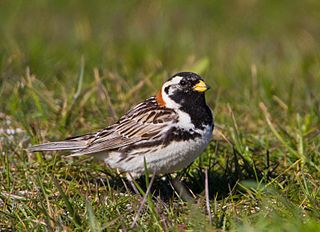
The Lapland longspur, also known as the Lapland bunting, is a passerine bird in the longspur family Calcariidae, a group separated by most modern authors from the Fringillidae.

The longspurs, genus Calcarius, are a group of birds in the family Calcariidae. The name refers to the long claw on the hind toe of each foot. The genus formerly included the thick-billed longspur, Rhyncophanes mccownii, which is now placed in a separate genus.
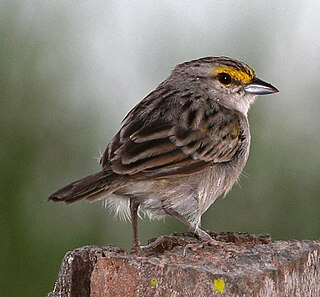
Ammodramus is a genus of birds in the family Passerellidae, in the group known as American sparrows. Birds of this genus are known commonly as grassland sparrows. The name Ammodramus is from the Greek for "sand runner".

Townsend's warbler is a small songbird of the New World warbler family.

Nannopterum is a genus of cormorant comprising three species. They are found throughout the Americas, hence the common name American cormorants.

The red-billed pied tanager is a species of bird in the family Mitrospingidae. It is found in Bolivia, Brazil, French Guiana, Guyana, Peru and Suriname. Placed in family Thraupidae, the "true" tanagers, for over two centuries, the International Ornithological Committee reclassified this species to Mitrospingidae in 2018.

The Puerto Rican owl or múcaro común, formerly known as the Puerto Rican screech owl, is a mid-sized "typical owl" in subfamily Striginae. It is endemic to the archipelago of Puerto Rico though it formerly also inhabited the Virgin Islands.

John Porter McCown was a career officer in the United States Army, fighting in the Mexican–American War and in the Seminole Wars. He also served as a general in the Confederate Army during the American Civil War.
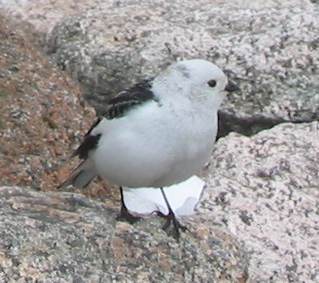
Plectrophenax is a small genus of passerine birds of the longspur family Calcariidae.

Synthliboramphus is a small genus of seabirds in the auk family from the North Pacific. The genus name Synthliboramphus is from Ancient Greek sunthlibo, "to compress", and rhamphos, "bill". The English name "Murrelet" is a diminutive of "murre", a word of uncertain origins, but which may imitate the call of the common guillemot.

New World sparrows are a group of mainly New World passerine birds, forming the family Passerellidae. They are seed-eating birds with conical bills, brown or gray in color, and many species have distinctive head patterns.

The Hispaniolan euphonia is a bird species in the finch family, Fringillidae that is endemic to the island of Hispaniola in the Caribbean.

Calcariidae is a small family of passerine birds. It includes longspurs and snow buntings. There are six species in three genera worldwide, found mainly in North America and Eurasia. They are migratory and can live in a variety of habitats including grasslands, prairies, tundra, mountains, and beaches.

Pseudastur is a genus of bird of prey in the family Accipitridae. It contains the following species:
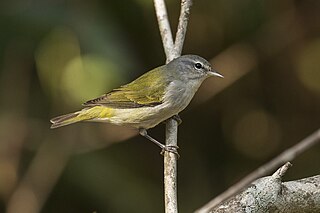
Leiothlypis is a genus of New World warbler, formerly classified within the genus Oreothlypis or Vermivora.

The Mitrospingidae is a family of passerine birds. It consists of three genera and four species. The family is found in South America and southern Central America. The family was identified in 2013, and consists of birds that have been traditionally placed in the family Thraupidae. The family was adopted by the American Ornithological Society in their 58th supplement of their checklist in 2017 and in the online list of birds maintained by Frank Gill, Pamela Rasmussen and David Donsker on behalf of the International Ornithological Committee (IOC).
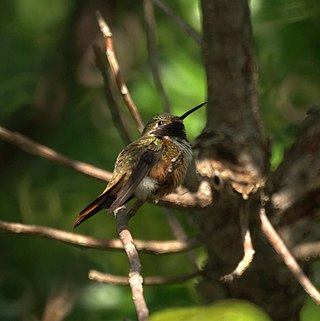
Nesophlox is a genus in the family of Hummingbirds. It consists of two endemic hummingbirds of the Bahamas.

Bird Names for Birds is a campaign to change the common names of American birds named after people, and to redress the recognition in ornithology of figures with racist or colonial pasts. Launched in June 2020 by ornithologists Jordan E. Rutter and Gabriel Foley with a public petition, in the midst of the George Floyd protests and in the aftermath of an incident in Central Park that paved the way to Black Birders Week, the movement emerged after several years of social activism by multiple American ornithologists and birders, many of whom are not affiliated with Bird Names for Birds but remain devoted to the cause. The inaugural petition, dated June 22, 2020, and co-signed by 182 individuals, urged the American Ornithological Society (AOS) to "acknowledge the issue of eponymous and honorific common names, to outline a plan to change harmful common names, and to prioritize the implementation of this plan". In 2023, the AOS formally announced that it would change all English-language bird names that are named directly after people.

Urile is a genus of birds in the family Phalacrocoracidae, commonly known as North Pacific cormorants. It contains 3 extant and 1 recently extinct species, all of which are or were found in the North Pacific Ocean.






















